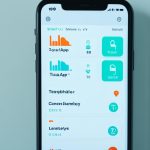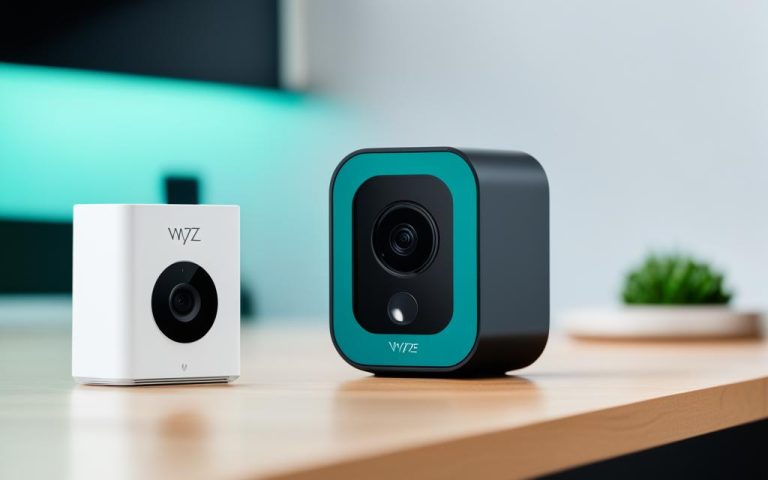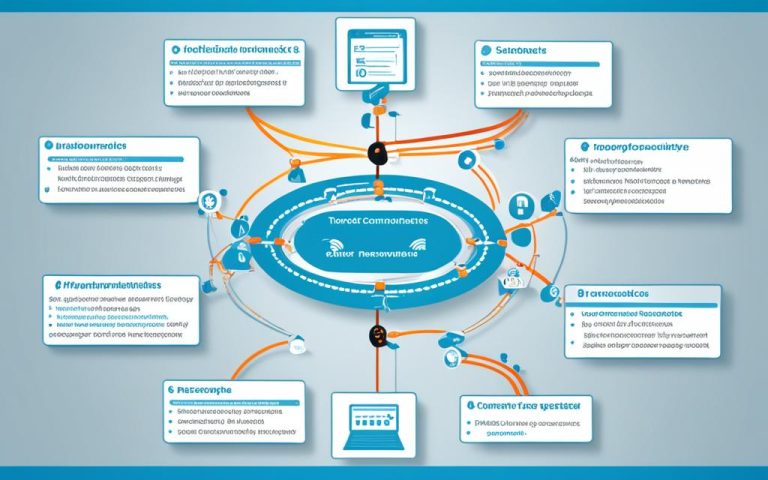Cell Network Search is a key system service in iOS devices. It uses location services to find your exact spot without GPS, like by using cell towers1. This service helps carriers know how to make their networks better by tracking cell tower use and connection issues1. It also helps with targeted ads, sales, and improving location-based services by using the data it gathers1.
You can choose to turn Cell Network Search on or off, along with other location services1. Turning it off might not change how your device works much, but it could affect your battery life1. Some users are concerned about Apple not sharing more about Cell Network Search, which makes them wonder about their privacy1. There are many discussions online about the privacy issues with Cell Network Search and similar services1.
Key Takeaways:
- Cell Network Search helps with location services by using cell towers1.
- This data is used for targeted sales, promotions, and improving infrastructure1.
- You can decide to use or not use Cell Network Search and other location services1.
- Turning off Cell Network Search might affect your battery but not the device’s main functions1.
- There are worries about privacy and data collection with Cell Network Search and similar services1.
Now, let’s look closer at how Cell Network Search works and its benefits.
How Cell Network Search Works
Cell Network Search is key for mobile devices to connect to the strongest network nearby. It ensures reliable and smooth cellular connectivity for users. Let’s explore how it works and the role of location services.
When a device searches for a cell network, it checks the signal strength of nearby towers. It uses location services to find the towers’ locations. This method, called cell tower triangulation, helps figure out where the device is.
This search looks for the best signal and connects to the tower with the strongest signal. This makes sure the device connects quickly and works well, giving users a great experience.
Cell Network Search also helps Apple and carriers. It gives them info on network use and how busy it is. This info helps improve the network and can be used for better ads.
Let’s look at some stats from link 32. When a device is in a weak signal area, it searches for the best tower to connect to. This keeps users connected even in poor signal areas. Turning off this search can save battery life, especially when always looking for a 3G connection. A user lost only 3% battery in an hour with it on2.
In summary, Cell Network Search is crucial for keeping mobile devices connected. It uses location services and scans for the best signal. This not only improves the user experience but also helps Apple and carriers manage their networks better.
Insights on Cell Network Search
| Functionality | Statistical Data |
|---|---|
| Multi-IMSI Capabilities | Traditional SIM cards stick to one network, but IoT SIMs like emnify’s can switch between networks for the best signal, connecting to several networks in one country3. |
| Automatic Network Selection | Most M2M/IoT devices, like those with emnify SIMs, automatically pick the best network available, following rules from 3GPP TS 23.1223. |
| Managed Automatic Network Selection | emnify’s Mobile Core Network picks the best network for SIMs, steering them away from bad networks3. |
| Manual Network Selection | For certain uses, devices can choose networks with commands like AT+COPS=? and AT+COPS. It’s smart to have fallback plans for staying connected3. |
| Forbidden List Functionality | This feature lists networks that won’t let devices connect, stopping them from trying automatically unless chosen by hand3. |
The Benefits of Cell Network Search
Cell Network Search has many advantages for users and service providers. It makes finding your location more accurate, especially when GPS isn’t working well4. This is great for apps and services that need precise location info4. It also helps Apple and carriers understand how people use their networks, letting them improve services4. Plus, it makes ads more relevant to where you are, which helps advertisers and users alike4.
Getting your exact location is key for many mobile services and apps. It lets businesses offer services just for you and work better. For example, delivery services can plan their routes better, saving money and making customers happier. Emergency services can find people faster, which could save lives. And network operators can see where their service is weak and fix it, making things better for everyone5.
Cell network search gives businesses and groups deep insights into how people act. Retailers can see where people go to plan their stores better. City planners can see how people move around to improve cities. Advertisers can target people when they’re near their stores or competitors5.
Also, cell network search helps keep your location private. Most of the time, your location is kept anonymous4. App makers and service providers must follow strict rules to keep your data safe. Laws and standards make sure your location info is secure and open, so you can relax4.
In short, cell network search boosts location accuracy, helps with network planning, targets ads better, and improves services. It also protects your privacy. This tech has changed how we move through the world, offering new chances for businesses, providers, and people.
| Benefits of Cell Network Search |
|---|
| Improved accuracy of location services |
| Enhanced network analysis |
| Targeted advertising based on geographical location |
| Optimized service delivery and operational efficiency |
| Privacy protection through anonymization of location data |
Privacy Concerns with Cell Network Search
Cell Network Search helps Apple and carriers by giving them data. But, it might make some users feel uneasy. It tracks where you are and which cell towers you use. This might seem like an invasion of privacy. But, Apple says the data is anonymous and used to make the network better.
Apple also lets users choose if they want to share their location or not. They tell users how they collect data too.
Users can turn off Cell Network Search if they’re worried about privacy or want to save battery life.
The US military uses lasers in the Middle East to shoot down drones. This shows how important it is to keep sensitive info safe6. President Biden signed laws to protect our national security and keep our information safe6.
In New York City, some gun-detection systems might wrongly flag people 85% of the time. This could mean innocent people get in trouble6. A big money laundering case with Tornado Cash shows how risky sharing financial data can be6.
Some Americans have been tracked using cell network methods. This shows how our privacy can be at risk6. Workers from North Korea have made over $6.8 million for their leader, Kim Jong-Un, by working in the US. This shows how privacy can be broken into by hidden operations6.
Privacy worries also come from Tesla cars’ cameras recording videos. Staff can see these videos, which might be a privacy issue6. The FBI took down BreachForums twice, showing the fight against cybercrime and the need to protect our info6.
Data Collection and Privacy on iOS Devices
Cell Network Search might make some people uneasy, but Apple is open about how it uses data. They give users ways to control their privacy. Let’s look at how to manage location services on iOS devices and keep your privacy safe.
| Location Services Settings | Description |
|---|---|
| Location Services Status | Users can enable or disable the overall Location Services feature on their device, giving them control over the accessibility of their location data. |
| Individual App Permissions | Users can manage location permissions for each app installed on their device, determining which apps are allowed to access their location data. |
| System Services | Users can customize which system services have access to their location, granting specific permissions to features like Emergency Calls & SOS, HomeKit, and Popular Near Me. |
| Significant Locations | This feature tracks the places users visit most often to improve the accuracy of maps. Users have the option to disable this feature if they have concerns about their privacy. |
| Selective Share My Location | The Share My Location feature allows users to send their device’s GPS location to family members in the Family Sharing group. This feature can be customized on a per-contact basis. |
| Location-Based Alerts | Users can choose to enable or disable location-based alerts from specific apps. This ensures that users only receive location-specific notifications from trusted sources. |
| Limit Ad Tracking | Users can enable this feature to limit personalized ads based on their location. It provides an extra layer of privacy when using apps that rely on ad targeting. |
By going into Location Services on their iOS devices, users can change their privacy settings. Apple gives many options to help users decide how they want to share their data. This shows Apple’s commitment to keeping user privacy safe.
The iPhone Analytics feature sends some data to Apple to improve GPS features. This doesn’t hurt personal privacy. It’s all about making the user’s experience better7.
For more info on managing location services and privacy on iOS devices, check this Apple support page.
In conclusion, Cell Network Search does raise privacy concerns. But Apple has steps to protect user privacy. Users can control their location settings and decide how much data to share. Knowing about these options helps users balance using location features and keeping their privacy safe on iOS devices.
Managing Location Services on iOS Devices
iOS devices let users manage their location services and privacy settings. Users can turn off location services or adjust app permissions in Settings > Privacy & Security > Location Services. They can choose from “Never,” “Ask Next Time,” “While Using the App,” or “Always” for app permissions. Users can also disable location tracking for certain iOS services, like Cell Network Search and Compass Calibration.
This gives users more privacy control while still using location services. Turning off Cell Network Search can save battery life and reduce data use8. Disabling Significant Locations stops Apple and partners from tracking your location8. The Routing & Traffic setting shares GPS data with Apple8.
Device Management might lead to surveillance, so it’s best to turn it off8. Disabling Network & Wireless settings affects Bluetooth, Wi-Fi, and Ultra Wideband on iOS devices8.
When setting up an iPhone, users are asked to enable Location Services. They can turn it on or off anytime9. Apps usually ask for location data the first time they use it. Users can choose to allow or deny access, and change permissions later9.
Disabling Location Services can affect iPhone features, showing its importance9.
Users can manage app permissions for location under Settings > Privacy & Security > Location Services. They can choose precise location, approximate location, or Ask Next Time9. It’s important to read app privacy policies to understand how they use location info9.
Users can hide maps in alerts for apps that need continuous location access in the background9. System services like location-based suggestions and ads also use Location Services. Users can manage these settings under System Services in Location Services9.
| Service | Purpose |
|---|---|
| Cell Network Search | Tracks a user’s location in relation to local cell towers to gather data on usage and congestion10 |
| Significant Locations | Tracks frequented places to enhance Apple Memories or for other purposes10 |
| Networking & Wireless | Disables automatic tracking for network eligibility determination10 |
| Apple System Services | Includes various features that utilize location tracking, such as Emergency Calls & SOS, HomeKit, Motion Calibration & Distance, Improve Maps, among others10 |
Managing location services on iOS devices helps users balance privacy and functionality. By disabling or customizing location permissions, users control their location data use. It’s key to regularly check and update location service settings to protect privacy8910.
Disabling Location Sharing and Protecting Privacy
Users can manage their location services to disable sharing and protect their privacy. For instance, in the Find My app, they can turn off location sharing and remove people from the app. This stops others from tracking them. They can also choose to share only an approximate location by turning off “Precise Location”.
Another way is to enable the “Status Bar Icon” under System Services. This shows an indicator in the status bar when an app is using location data. These steps give users more control over their location and help keep their privacy safe.
Disabling Location Sharing in the Find My App
The Find My app lets users share their location with others. By turning off location sharing, they stop others from tracking them11. This is great for keeping their privacy and making sure only trusted people know where they are.
Limiting Location Data Precision
Users can share only an approximate location instead of the exact one. By disabling “Precise Location” in settings, apps get only general location info11. This adds an extra layer of privacy.
Showing Location Data Access
Enabling the “Status Bar Icon” under System Services gives users a visual clue when an app is using their location. This icon appears in the status bar, letting them know their location is being accessed11.
Take Control of Your Location Information
Disabling location sharing and adjusting location settings are key to protecting privacy on iOS devices. By being aware of location services and managing sharing, users can control their location info. This way, they can avoid unwanted tracking11.
| Disabling Location Sharing and Protecting Privacy Measures | Benefits |
|---|---|
| Toggle off location sharing in the Find My app | Prevents others from tracking your location |
| Turn off “Precise Location” | Share only approximate location data |
| Enable “Status Bar Icon” | Get visual notification when an app uses location services |
The Importance of Location Services for App Functionality
Location services are key for app functionality on iOS devices. They offer many useful features and personalized experiences. Apps use GPS, Wi-Fi, and cellular networks for location data. This data makes apps more convenient, helps with navigation, and makes them more engaging.
One big plus of location services is accurate mapping and navigation. GPS can pinpoint a location within a few meters12. This means apps can give users directions and the best routes. It’s great for exploring new places or finding the nearest coffee shop.
Location services also make location-based reminders possible. Users can set alerts based on where they are. Apps use GPS and other tech13 to remind users when they arrive or leave certain places. This is super useful for keeping track of tasks, meetings, and daily life.
The Relationship Between Location Services and App Functionality
Location services are the base for many app features. They make apps more personalized to what users need. By turning on location services, users get access to more app features and better performance.
For example, location data helps apps deliver content that’s relevant to where you are. This could be info on nearby attractions, popular spots, or local news. Without accurate location data, apps can’t give users personalized or location-specific content. This limits what apps can do.
Location services also help with social media by letting users check-in, share where they are, or find friends nearby. These features rely on real-time location data to connect people. By using location services, apps can build communities and help users connect with others.
Protecting User Privacy While Leveraging Location Services
Even though location services are useful, privacy concerns are important. To address these, users can control their location settings and which apps can see their location data.
Users can check and manage which apps can see their location in the device settings. By going to Settings > Privacy > Location Services, users can turn location access on or off for each app. This lets users limit which apps know where they are, keeping their privacy safe.
To add more privacy, users can use VPNs to encrypt their internet traffic. VPNs hide what internet service providers can see, keeping user data safe and private12. This extra protection ensures that user data stays secure.
The Balance Between App Functionality and Privacy Preferences
Users need to find a balance between using location services and protecting their privacy. Turning off location services might limit some app features. But it’s important for users to know the effects and only change settings that fit their privacy needs.
It’s a good idea for users to check the privacy policies of apps and services they use. Reading terms and conditions, knowing how data is collected, and understanding location data use helps users make smart choices about sharing their data.
Benefits of Customizing Location Services
Customizing location services on iOS devices helps users balance privacy, battery life, and functionality. By adjusting their location settings, users can control their data and get a personalized mobile experience.
Protecting Privacy
Customizing location services protects your privacy. You can choose when and how apps use your location. This ensures your data is used for meaningful purposes only.
- Apps may ask for limited or full access to your location14.
- Apple uses location data for personalized recommendations but doesn’t share precise location for suggestions if you turn off the service14.
With these settings, you can be sure your exact location isn’t shared without your okay.
Conserving Battery Life
Customizing location services also saves battery life. By turning off unused location services and adjusting app permissions, you can make your device’s battery last longer.
- Apple uses location data to show you when places are open and busy14.
- Your iPhone uses location to control HomeKit accessories, like turning on lights when you get home14.
- It also optimizes battery charging at home based on your location14.
By turning off unused location services, your battery can last all day.
Enhancing Functionality
Customizing location services also boosts your device’s functionality. You can turn on or off location-based features to match your needs and preferences.
- Your iPhone sends GPS data to Apple for crowd-sourced traffic info while you’re moving14.
- It uses location to control HomeKit accessories, like turning on lights when you arrive14.
- Significant Locations keeps track of places you’ve visited for personalized services like traffic routing and photo Memories14.
- iPhones and Apple Watches use location for alerts, reminders, and automations based on your location14.
Customization lets you use location data for personalized services, automation, and better functionality.
| Benefits of Customizing Location Services | References |
|---|---|
| Protecting Privacy | 14 |
| Conserving Battery Life | 14 |
| Enhancing Functionality | 14 |
Customizing location services on iOS devices has many benefits. It lets users keep their data private while still enjoying their devices fully. By finding the right balance, users can protect their data, save battery life, and unlock their devices’ full potential.
Conclusion
Cell Network Search is key to making location services on iOS devices more accurate. It uses both network and device methods to find devices within 50 meters in busy areas15. With over 307,000 cell towers in the U.S., it’s a big part of wireless networks, especially with Verizon’s 70% 4G coverage16.
Cell network search helps with precise location and a better user experience. But, keeping our privacy safe is also crucial. iOS lets users control their location settings. This way, they can balance privacy with the need for location services.
Studies show no link between mobile phones and brain tumors or head cancers after 10 years of use17. Also, animal and human studies suggest radio frequency fields don’t raise cancer risks in people. Yet, research continues to explore how these fields affect brain activity and sleep.
In summary, cell network search and location services on iOS devices make life easier and more convenient. They also let users manage their privacy. By understanding the benefits and concerns, users can make choices that fit their needs and values.
FAQ
What is Cell Network Search?
Cell Network Search is a system in iOS devices that uses location services to find your location. It does this by using cell towers to triangulate your position. The data it collects helps improve location services and gives info to carriers.
How does Cell Network Search work?
It scans nearby cell towers to find the strongest signal. Then, it uses location services to get info on the tower’s location and signal strength. This helps figure out where you are, a process called cell tower triangulation.
What are the benefits of Cell Network Search?
It makes location services more accurate. It helps Apple and carriers analyze the network. And it allows for targeted ads based on where you are.
Are there any privacy concerns with Cell Network Search?
Yes, it collects your location and cell tower info. But, this data is made anonymous and used for network improvements. Apple protects your privacy by letting you choose to share your location and being open about how they use your data.
How can I manage location services on my iOS device?
Go to Settings > Privacy & Security > Location Services to manage location services. There, you can see which apps use your location and set their permissions.
How can I disable location sharing and protect my privacy?
Turn off location sharing in the Find My app. Disable “Precise Location” for apps. And use the “Status Bar Icon” to know when apps are using your location.
Why are location services important for app functionality?
Location services are key for many apps and services on iOS. They make features like maps, navigation, reminders, and personalized content possible.
What are the benefits of customizing location services?
Customizing location services helps balance privacy and app functionality. By turning off what you don’t need and adjusting app permissions, you protect your privacy, save battery life, and control your location data.
What is the overall purpose of Cell Network Search and managing location services?
The goal is to improve location accuracy, help with network analysis, and give you control over your privacy. This way, you can enjoy location-based services without sacrificing your privacy.
Source Links
- https://discussions.apple.com/thread/3436532 – What does Cell Network Search do?
- https://forums.macrumors.com/threads/cell-network-search-in-system-services.1275047/ – cell network search in system services
- https://www.emnify.com/iot-glossary/network-selection – Network Selection Explained | IoT Glossary
- https://onlinesafetyzone.com/learn/smartphone-location-tracking.php – Smartphone Location Tracking – Online Safety Zone
- https://onomondo.com/blog/improve-coverage-with-automatic-network-selection/ – Improve cellular coverage with automatic network selection
- https://www.wired.com/story/ss7-vulnerability-spies-north-korea-tesla-breachforums/ – US Official Warns a Cell Network Flaw Is Being Exploited for Spying
- https://www.lifewire.com/protect-private-info-stored-iphone-1999197 – How to Protect Private Info Stored on Your iPhone
- https://www.shefinds.com/collections/iphone-settings-turn-off-battery/ – The iPhone System Settings You Should Turn Off Right Away Because They Can Track Your Location, Collect Data, And Drain Your Battery
- https://support.apple.com/guide/iphone/control-the-location-information-you-share-iph3dd5f9be/ios – Control the location information you share on iPhone
- https://www.dextech.co.nz/blogs/news/how-to-turn-your-iphone-location-service-off-or-on – How to turn your iPhone location services on or off
- https://www.moutfitters.com/blog/hidden-iphone-privacy-settings-a-guide/ – Hidden iPhone Privacy Settings: A Guide
- https://www.envistaforensics.com/knowledge-center/insights/articles/is-my-cell-phone-tracking-me-if-i-turn-off-location-services/ – Is My Cell Phone Tracking Me If I Turn Off Location Services? | Envista Forensics
- https://fnmedia.us/2023/04/09/more-opt-out-iphone-settings/ – More Opt-Out iPhone Settings – FNMedia Ltd Co
- https://www.apple.com/legal/privacy/data/en/location-services/ – Legal – Location Services & Privacy – Apple
- https://en.wikipedia.org/wiki/Mobile_phone_tracking – Mobile phone tracking
- https://millmanland.com/knowledge/what-is-a-cell-tower-and-how-does-a-cell-tower-work/ – What Is a Cell Tower and How Does a Cell Tower Work? | Millman National Land Services
- https://ec.europa.eu/health/scientific_committees/opinions_layman/en/electromagnetic-fields/l-2/5-conclusions-mobile-phones.htm – 5. Conclusions on mobile phones and radio frequency fields



















